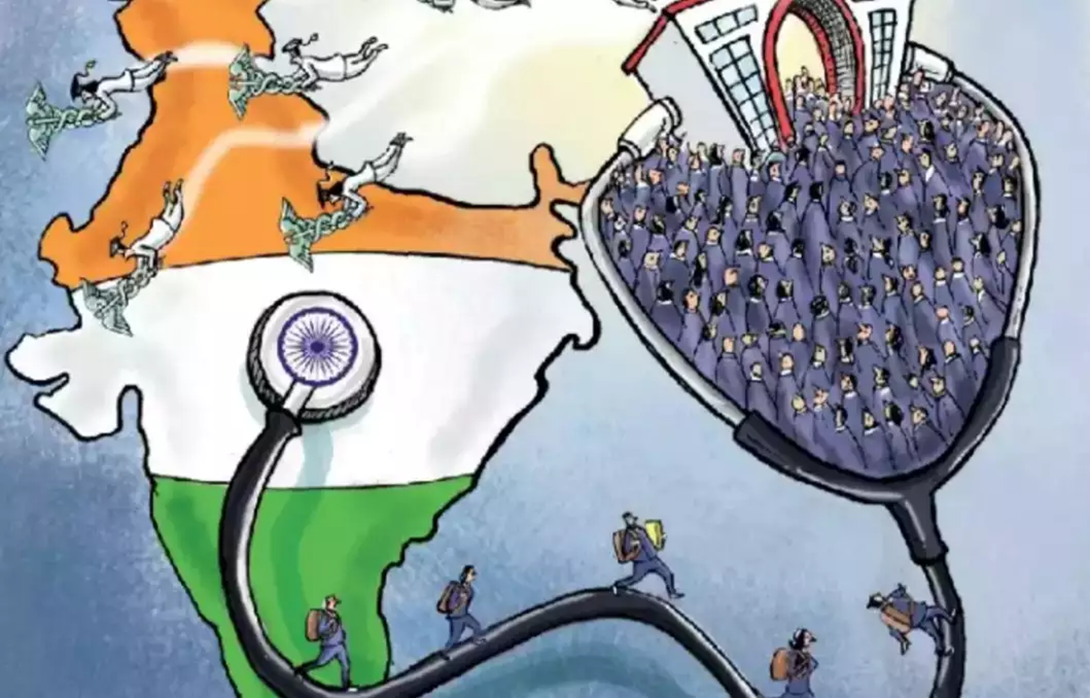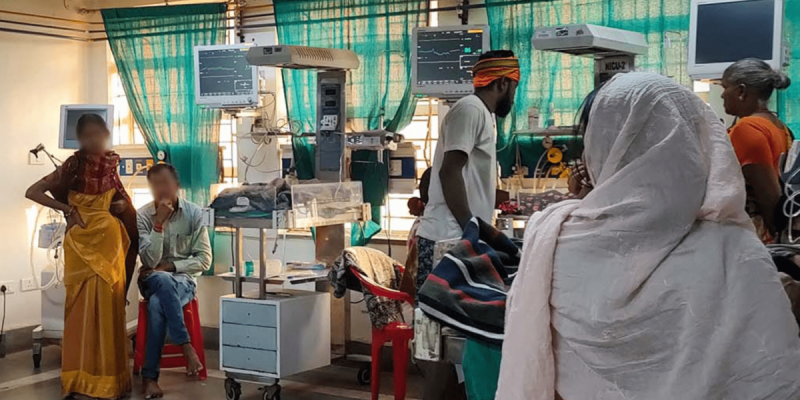- Courses
- GS Full Course 1 Year
- GS Full Course 2 Year
- GS Full Course 3 Year
- GS Full Course Till Selection
- MEP (Mains Enrichment Programme) Data, Facts
- Essay Target – 150+ Marks
- Online Program
- GS Recorded Course
- NCERT- First Ladder
- Polity
- Geography
- Economy
- Ancient, Medieval and Art & Culture AMAC
- Modern India, Post Independence & World History
- Environment
- Governance
- Science & Technology
- International Relations and Internal Security
- Disaster Management
- Ethics
- Current Affairs
- Indian Society and Social Issue
- CSAT
- 5 LAYERED ARJUNA Mentorship
- Public Administration Optional
- ABOUT US
- OUR TOPPERS
- TEST SERIES
- FREE STUDY MATERIAL
- VIDEOS
- CONTACT US
India's Quest for Universal Health Coverage
India's Quest for Universal Health Coverage
16-08-2024

India is moving towards universal health coverage, as evidenced by recent reports and surveys. Positive trends in reducing health-related financial burden and improving access to healthcare are evident.
- However, challenges such as inequalities in access to healthcare, rising non-communicable diseases, and other systemic issues remain.
Key Issues in India's Healthcare Sector
-
Misaligned Priorities:
- Infrastructure vs. Outcomes: While India has improved healthcare infrastructure, outcomes have lagged. The National Health Mission has increased the number of health centers, but many public facilities still do not meet basic standards. For instance, under Ayushman Bharat, there have been issues such as patients marked as 'dead' still receiving treatment.
- Quality vs. Quantity: There is a focus on increasing the number of facilities rather than improving the quality of care. Despite more institutional deliveries, the maternal mortality rate remains high.
-
Digital Divide:
- Telemedicine vs. Accessibility: The Covid-19 pandemic accelerated the use of telemedicine through platforms like eSanjeevani. However, this has widened the gap between urban and rural areas. Nearly 45% of the rural population lacked internet access in 2023, limiting their ability to benefit from digital health services.
-
Brain Drain and Skill Mismatch:
- Healthcare Workforce Shortages: India faces a shortage of qualified healthcare professionals. Although the doctor-population ratio is better than the WHO standard, there is a mismatch in specialized fields, like geriatric care. Additionally, there are fewer new graduates choosing careers in family medicine or rural healthcare.
-
Out-of-Pocket Expenses:
- Financial Barriers: Despite initiatives like Ayushman Bharat, many households still face high out-of-pocket expenses. Over 17% of Indian households incur catastrophic health expenditures annually, making healthcare financially burdensome.
-
Preventive Healthcare Neglect:
- Rising Non-Communicable Diseases: While communicable diseases have decreased, non-communicable diseases (NCDs) now account for 63% of deaths in India. There is a lack of emphasis on preventive measures such as health education, lifestyle changes, and early screenings.
-
Quality of Care Issues:
- Variability and Negligence: The quality of healthcare varies widely. Poor care quality has led to more deaths than insufficient access to healthcare. Issues such as medical negligence and lack of standardization contribute to a credibility crisis in the healthcare system.
-
Mental Health Crisis:
- Neglected Aspect: Mental health is a severely neglected area, with 60 to 70 million people suffering from mental disorders. India has a high suicide rate, and the shortage of mental health professionals exacerbates the problem. Despite the Mental Healthcare Act 2017, there is a lack of adequate mental health services.
-
Pharmaceutical Industry Challenges:
- Quality and Dependence Issues: The pharmaceutical industry faces challenges like quality control issues and over-reliance on imports for active pharmaceutical ingredients (APIs). For instance, in 2023, WHO warned against certain India-made cough syrups linked to child deaths in Uzbekistan.
Major Healthcare Initiatives in India
-
Ayushman Bharat:
- Components:
- Pradhan Mantri Jan Arogya Yojana (PM-JAY): Provides health insurance coverage of ₹5 lakh per family per year for secondary and tertiary care.
- Health and Wellness Centers: Aims to establish 150,000 centers to offer comprehensive primary healthcare.
- Components:
-
National Health Mission (NHM):
- Components:
- National Rural Health Mission (NRHM)
- National Urban Health Mission (NUHM)
- Focuses on improving healthcare infrastructure and reducing maternal and infant mortality.
- Components:
-
National Digital Health Mission (NDHM):
- Objectives: Creates a digital health ecosystem with unique health IDs, digitized health records, and a registry of doctors and health facilities.
-
Pradhan Mantri Swasthya Suraksha Yojana (PMSSY):
- Goals: Corrects regional imbalances by setting up new AIIMS institutions and upgrading government medical colleges.
-
Mission Indradhanush:
- Objective: A vaccination program aimed at increasing immunization coverage among children and pregnant women.
-
Janani Suraksha Yojana (JSY):
- Focus: Promotes institutional delivery among poor pregnant women through cash assistance.
-
Pradhan Mantri Bharatiya Janaushadhi Pariyojana (PMBJP):
- Aim: Provides quality medicines at affordable prices through Janaushadhi Kendras.
-
National Mental Health Program (NMHP):
- Objective: Provides accessible and affordable mental healthcare services.
Measures to Revamp India's Healthcare Sector
-
Bridging the Urban-Rural Divide:
- Mobile Health Units: Use mobile health units with telemedicine facilities and diagnostic tools to improve rural healthcare access. Successful models like Tamil Nadu's Mobile Medical Units can be scaled up.
-
Strengthening Primary Health Care:
- Health and Wellness Centers: Upgrade and fully staff the 150,000 centers promised under Ayushman Bharat. Implement a family physician model for continuity of care.
-
Public-Private Partnerships:
- Collaboration: Develop a framework for PPPs in healthcare to improve hospital management, diagnostic services, and specialized care. Replicate successful models like Rajasthan's partnership with Narayana Health.
-
Digital Health Ecosystem:
- Interoperability: Build a comprehensive digital health ecosystem with standardized Electronic Health Records (EHRs) and a Health Information Exchange (HIE) for better data sharing and care coordination.
-
Boosting Indigenous R&D:
- Investment: Increase healthcare R&D spending to 2.5% of GDP. Establish biomedical research parks to promote collaboration between academia, industry, and healthcare providers.
-
Enhancing Healthcare and Pharmaceutical Standards:
- Quality Control: Implement robust quality control measures and accreditation systems for healthcare and pharmaceutical facilities. Regular audits and transparent reporting can drive quality improvement.
Conclusion
India is making progress towards universal health coverage, with significant initiatives aimed at improving access and affordability. However, challenges such as disparities in care, the rise of non-communicable diseases, and issues within the healthcare system persist. By addressing these issues and implementing strategic measures, India can work towards a more equitable and effective healthcare system for all its citizens.
Must Check: Best IAS Coaching In Delhi
UPSC Prelims Result 2024 Out: Expected Cut Off & Other Details, UPSC Prelims 2024 Answer with Explanation, Daily Prelims Quiz, Daily Current Affairs, MONTHLY CURRENT AFFAIRS TOTAL (CAT) MAGAZINE, Best IAS Coaching Institute in Karol Bagh, Best IAS Coaching Institute in Delhi, Daily Mains Question Answer Practice, ENSURE IAS UPSC Toppers, UPSC Toppers Marksheet, Previous Year Interview Questions, UPSC Syllabus
India’s EV Mission: Progress Delayed, Not Denied
India’s EV Mission: Progress Delayed, Not Denied



